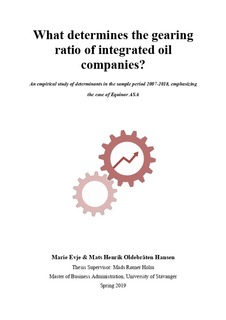| dc.description.abstract | Analysis
To analyze the determinants of gearing ratio, we have utilized panel data regressions. Our sample period from Q1 2007 - Q3 2018 has been divided into three sub-periods; before, during, and after the 2014 oil crisis. To get a more complete perception of what drives the gearing ratio of oil companies, we have studied the case of Equinor ASA against a set of peers. Our regressions consist of a dependent variable and nine explanatory variables. The dependent variable is the gearing ratio of 56 selected companies, and the explanatory variables are; current ratio, profitability, size, LIBOR, tangibility, tax shield, robustness, oil price, and credit rating. To uncover possible relationships with gearing, we have tested the impact of these independent variables’ regression coefficients on the dependent variable.
MAIN RESULTS
Firstly, our study concludes that there is no significant relationship between credit rating and gearing. This was astonishing to us as economic intuition, as well as conversations with professionals, suggest that credit ratings play a vital role in ensuring a company’s access to capital. The factor was not found significant in any of our time periods.
Secondly, a significant relationship was found between liquidity and the gearing ratio. This was found in all of our sample periods, including the comparison of Equinor ASA against its peers. Additionally, liquidity was found to have a frequently stronger effect on oil companies compared to non-oil companies. The latter is supported by our finding that liquidity is the only common determinant when investigating Equinor ASA and its peers.
Our thesis contributes to existing research and discussion on the subject of capital structure. It can further be of relevance to top management by providing knowledge of what determinants to be especially aware of when attempting to manage their company’s gearing. | nb_NO |
